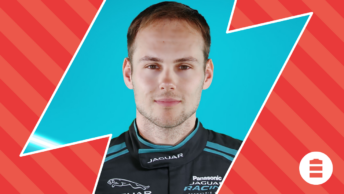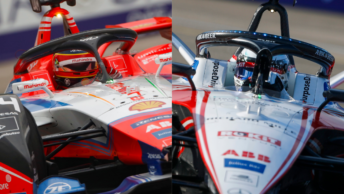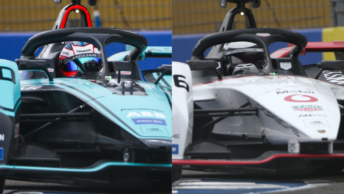This week, after a five month break since racing in Marrakech in February, Formula E is finally, really back. With a rapid-fire six races in a gruelling nine-day schedule, here’s what you might have forgotten about the season so far – and what’s to play for in Berlin E-Prix season finale.
Big names, bigger expectations
At testing last year, if you can imagine trying to even think back to October 2019, there was one big story: the arrival of Porsche and Mercedes to Formula E.
Both were turning up with new factory teams – Mercedes inheriting the entry of customer outfit HWA who’d done a sort of dress rehearsal over Season 5 as Venturi customers, with the favour now reversed to supply the Monegasque outfit with German power.
At testing the two marques declared modest aims – perhaps a podium, as a goal, at some point during the season. Mercedes’ Stoffel Vandoorne had managed it with HWA the previous year and Porsche’s Andre Lotterer had been no stranger to the champagne during his two previous seasons with DS Techeetah, so it was reasonable at the time to assume they were on course for that. And might just be downplaying their chances a bit, despite relative inexperience.
At Valencia the times – unrepresentative though everyone has to emphasise they are, at what’s very much not a Formula E track – showed Envision Virgin in a strong light, with BMW, Jaguar and DS Techeetah all close behind them. Sam Bird topped Tuesday’s session and Robin Frijns the following day, before Max Günther closed the week off by proving why he’d got the factory seat.
But you can’t read too much into test times – the MGU noises, on the other hand…
Five rounds, five winners, five championship leaders
Formula E has run five rounds so far this season – which means the majority of races are yet to come, in Berlin. Not only does that mean absolutely all the drivers (even the ones stepping into cars for the first time this season at Tempelhof) are still in the title running, it also puts pressure on the seven drivers who have a reasonable shot at it to find some consistency the first rounds have mostly kept from them.
Sam Bird took the lead at round one in Diriyah after taking the first victory this season, then handed off to Alexander Sims as we left Saudi Arabia, who in turn passed the lead to Stoffel Vandoorne on the way back from Santiago. Mitch Evans’ Mexico win saw him grab the top spot but Antonio Felix da Costa was able to make good on a run of podiums in Marrakech to reclaim it by the time the season was suspended.
The only race winner not to lead the championship has been Max Günther, who took the Santiago top spot but not the overall lead, while Vandoorne is the only leader not to have bagged a win.
Antonio Felix da Costa goes into the Tempelhof rounds on 67 points, leading from second-placed Mitch Evans by 11 points. But with 180 on the table, everything could easily change.
What actually happened?
You’d be entirely forgiven for having forgotten what went on in the first five races – now longer ago than the four-month period they happened over. Here’s our crib notes on what mattered…
Round one: Diriyah
Pole: Alexander Sims (BMW Andretti)
Winner: Sam Bird (Envision Virgin)
A startlingly sensible race, by Formula E standards, marred only by Sebastien Buemi having a weird moment and nearly rejoining into the middle of the pack after an off. Sims couldn’t manage to hold off Bird from pole and ended up a slightly messy eighth, with energy management issues while Andre Lotterer and Stoffel Vandoorne made good on Porsche and Mercedes’ podium goals in the very first race.
Round two: still Diriyah
Pole: Alexander Sims (BMW Andretti)
Winner: Alexander Sims (BMW Andretti)
A much more typical Formula E race with nearly non-stop shenanigans. Several safety car periods led to drivers going off-line to activate Attack Mode – and controversy when Max Günther didn’t let Lucas di Grassi back ahead of him to do so. Although both BMW drivers stood on the podium, second-placed Günther was penalised (along with about half the field) and demoted post-race.
Round three: Santiago de Chile
Pole: Mitch Evans (Jaguar Racing)
Winner: Max Günther (BMW Andretti)
The Santiago round is fast and hot, a real battery-strainer in terms of pushing thermal limits and with energy at a premium while drivers try not to overcook anything with regen. Evans took pole but a dashboard issue in the opening laps of the race saw him overconsume energy and unable to hold more than third by the end of the race, while Günther – on a revenge mission from his Diriyah demotion – was able to hold out at the front despite an incredible charge from Da Costa showing the real pace of the Techeetahs.
Round four: Mexico City
Pole: Andre Lotterer (Porsche)
Winner: Mitch Evans (Jaguar Racing)
Mexico usually produces dramatic on-track action – unusually, that stemmed partly from the track itself this year, as Formula E’s ridged tyres started to dig up the tarmac in the more intense parts of the track. Daniel Abt had a shocking crash in practice that saw him sent to a local hospital for checks and although he did compete in the race, clearly struggling with pain. Lotterer took pole for Porsche, narrowly pipping a hungry-for-comeback Evans but was unable to do much more than slide backwards in the race, the Jaguar immediately bagging him at turn one. Elsewhere, Sam Bird’s appalling run of luck continued as a season that had started so well fell apart in incident after incident.
Round five: Marrakech
Pole: Antonio Felix da Costa (DS Techeetah
WInner: Antonio Felix da Costa (DS Techeetah)
A dramatic outing for Techeetah – and the whole paddock – as no one was sure if we were about to be quarantined in Marrakech, following JEV being sent for coronavirus testing. Fortunately, he tested negative and was deemed fit to race but very much barely, putting in an impressive rise from eleventh to third while barely able to stand on the podium. Meanwhile, teammate Da Costa continued battling the driver in his old car as Günther very much didn’t let him take a simple lights-to-flag victory but in the end, the Techeetah took the win.d
Car swaps
It’s not back as a feature but it might as well be, in some teams. Over the break Daniel Abt got fired from Audi after a bizarre controversy in the Race At Home challenge, which left his seat open for factory DTM driver and one-time Formula E race participant Rene Rast to line up in, alongside Lucas di Grassi.
Then immediately after the Race At Home challenge, Mahindra and Pascal Wehrlein announced they were parting ways – with Pascal assumed to be off to Porsche but not yet in the seat for the Berlin Races. In his stead at Mahindra, Alex Lynn is making his second consecutive mid-season comeback and hoping to make it stick, this time.
At NIO 333, despite the team’s determination to represent China in every role, Ma Qinghua was unable to get around travel restrictions for the Tempelhof races and so Daniel Abt was drafted back in, as a super-sub alongside Oliver Turvey.
And finally at Dragon, a team notable for its revolving door policy on drivers during the previous season, Brendon Hartley made an exit while 22-year-old former F2 driver Sergio Sette Camara will be stepping in to boost Formula E’s Brazilian contingent. Unusually, Sette Camara will actually be the driver in Berlin with the most recent official track session under his belt come shakedown, having driven for Dragon in this February’s Marrakech rookie test.
Expecting the unexpected
It’s very hard to predict anything about the upcoming races because we’ve never seen an event like this. Less like a regular Formula E event – which, don’t forget, often have gaps of up to six weeks between races – and much more like an endurance race in terms of the stresses and strains on technology, drivers and teams.
Tempelhof will be a balmy 27 to 31C over the course of the races and despite the races running in cooler evening air, practice and qualifying sessions will be in the full sun of the exposed former runway. Expect McLaren to be sweating over the batteries as much as the drivers – and for efficiency to play a huge part in the end races.
Formula E have never run an event like this before, where driving the first race you’re effectively driving the sixth – plenty of the paddock have endurance racing experience, which might come in very handy for the 216 Stunden von Tempelhof.





